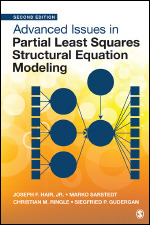Advanced Issues in Partial Least Squares Structural Equation Modeling
Second Edition
- Joseph F. Hair, Jr. - University of South Alabama, USA
- Marko Sarstedt - Ludwig-Maximilians-University, Munich, Germany, Babes-Bolyai University, Romania
- Christian M. Ringle - Hamburg University of Technology, Germany
- Siegfried P. Gudergan - James Cook University, Australia, Aalto University, Finland, Vienna University of Economics and Business, Austria
Courses:
Intermediate/Advanced Statistics | Quantitative Data Analysis | Quantitative/Statistical Research in Business & Management | Quantitative/Statistical Research in Business & Management | Statistics - General Interest | Structural Equation Modeling, Hierarchical Linear Modeling, & Multilevel Modeling | Structural Equation Modeling, Hierarchical Linear Modeling, & Multilevel Modeling
Intermediate/Advanced Statistics | Quantitative Data Analysis | Quantitative/Statistical Research in Business & Management | Quantitative/Statistical Research in Business & Management | Statistics - General Interest | Structural Equation Modeling, Hierarchical Linear Modeling, & Multilevel Modeling | Structural Equation Modeling, Hierarchical Linear Modeling, & Multilevel Modeling
October 2023 | 256 pages | SAGE Publications, Inc
The Second Edition of Advanced Issues in Partial Least Squares Structural Equation Modeling offers a straightforward and practical guide to PLS-SEM for users ready to go further than the basics of A Primer on Partial Least Squares Structural Equation Modeling, Third Edition. Even in this advanced guide, the authors have limited the emphasis on equations, formulas, and Greek symbols, and instead rely on detailed explanations of the fundamentals of PLS-SEM and provide general guidelines for understanding and evaluating the results of applying the method. A single study on corporate reputation features as an example throughout the book, along with a single software package (SmartPLS 4.0) to provide a seamless learning experience. The approach of this book is based on the authors’ many years of conducting research and teaching methodology courses, including developing the SmartPLS software. The preparation of the book, especially this new edition, is based on the authors’ desire to communicate the PLS-SEM method to a much broader audience from management and marketing to engineering, geography, medicine, political and environmental sciences, psychology, and beyond. The Second Edition includes a new chapter on the necessary condition analysis (NCA) and covers the most recent developments in PLS-SEM, with detailed guidelines for estimating and validating higher-order constructs and nonlinear effects as well as more insights on multigroup and latent class analyses using FIMIX-PLS and PLS-POS. The book is aimed at researchers and practitioners who seek to gain comprehensive knowledge of more advanced PLS-SEM methods.
Chapter 1: An Overview of Recent and Emerging Developments in PLS-SEM
Chapter 2: Higher-order Constructs
Chapter 3: Advanced Modeling and Model Assessment
Chapter 4: Advanced Results Illustration
Chapter 5: Modeling Observed Heterogeneity
Chapter 6: Modeling Unobserved Heterogeneity
I plan on adopting - and incorporating - this text into CRJU 3610 (Statistical Analyses in Criminal Justice) beginning Spring 2025.
Criminal Justice Dept, Georgia State University - Atlanta
May 23, 2024

 Sage College Publishing
Sage College Publishing

